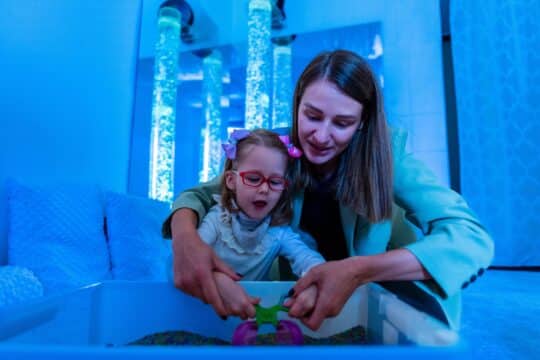Teachers are experiencing a new wave in the educational institution pertaining to new forms of instruction. And while these “new” terms have existed for awhile, it was only after the pandemic hit full force that educators had to reflect upon new ways to not only deliver instruction to their students at home in quarantine, but also learn these new strategies themselves. Hence, the debate arose surrounding virtual learning, either synchronously or asynchronously.
Any person working in an educational career instantly became a first-year teacher in survival mode. The frenzy of training on new technology, surveying communities for internet connectivity, maintaining mental health for themselves and their students, and protecting their own families certainly increased the anxiety in teachers’ lives. Add in the elements of trying to instruct in a whole new era with not much preparation time, and it’s no surprise teachers were worried about shutting down.
With only a slight break at this point for educators in the COVID-19 onslaught, instruction is occurring in numerous and varied ways, and there are multiple benefits to be found in the synchronous and asynchronous instruction models.
What is Synchronous Instruction? What are its Benefits?
In order to best understand synchronous vs. asynchronous instruction and the benefits with each model, teachers must understand the definition of each form of instruction. Synchronous instruction refers to real-time learning wherein instructors and students are not in the same physical location but are gathered virtually at the same time, often through an online meeting platform in small or large groups. This online instructional method delivers the chance for students to listen to lectures, view educational visual aids, and interact with the educator across major geographical distances.
Numerous benefits are attached to the synchronous learning model, including providing powerful opportunities for students and teachers to maneuver through content collaboratively, similar to being in a physical classroom; ensuring the ability to ask in-depth questions and provide feedback instantaneously; assessing the audience appropriately, whether formatively or summatively; and possibly re-teaching curriculum when it is necessary to further the educational learning.
One advantage of synchronous instruction is that it still offers a virtual form of face-to-face interactions between instructors and students. The ability to ask questions and explore ideas through discussions is an integral building block in learning. This virtual pathway still permits teachers to present information and read their students. Not only can questions be answered, but follow-up thoughts can be conveyed and can dictate a pathway toward new ideas as well. Teachers can guide their students through new content and support them in strategic ways. As long as the instruction occurs in real time, all parties can be involved in the learning process.
Building on the instruction element, being able to assess immediately is another benefit of the synchronous model. In order to better know what students are learning and comprehending, teachers can use multiple assessment methodologies in order to confirm learning or to reteach a component. Whether it’s a formal quiz or through small group presentations, an educator might adjust instruction when it becomes necessary. Any misconceptions can be corrected in just a few moments.
The online environment may even provide some benefits in decreasing anxieties, as it provides a chat function in which students can formulate questions for instructors who are often monitoring those questions and then providing answers. Students may feel less pressure when proposing queries through this format.
What is Asynchronous Instruction? What are its Benefits?
In some opposition to the synchronous model, the asynchronous form of instruction is an online student-centered platform in which students can work at their own individual pace and speed. It does not require a certain meeting time; no instructor is present, though they may offer specific office hours at certain points so students can connect with them; and it provides ultimate flexibility in work schedules.
One major benefit of asynchronous instruction is that students can access it at any point. They are not tethered to a fixed schedule so their time and pacing is adjustable. It’s a consistent form of instruction, often fixed, in which students can process, move ahead, or take time to review when it is needed.
Instructors can develop the entire learning path in this online mode and then provide access when it is complete. The asynchronous method has educators frontload it with the curriculum and lesson planning, and then students move through their self-paced instruction. They won’t be exhausted by meetings and lectures and can dedicate their time to intrinsic processing of materials.
Finally, while assessments may initially be designed as static in this model, they can eventually be flexibly formulated to opt-out of tasks or activities and provide other forms of differentiation to accommodate different levels of student learning.
Determining Which to Use
With both models of instruction having multiple advantages, it begs the question of which one to implement. In fact, both synchronous and asynchronous learning can occur through strongly connected designs.
A teacher who is trying to model communication and depth of discovery through discussion should create that atmosphere through the synchronous model. Here, human connectivity is important for the development of critical thinking and learning. Teachers will handily meet listening and speaking objectives as they communicate synchronously.
At the same point, asynchronous learning can grant occasions for students to maneuver through an individual assignment or activity that doesn’t require instant feedback or a class that builds upon prior content and doesn’t necessitate having a teacher available.
And, of course, there is the blended option, which incorporates both models into a classroom. It’s a serious combination of varying elements, fluctuating between live lectures and recorded lectures for students to review; real-time discussions and self-paced follow-ups; and collective presentations and projects in conjunction with contactless, self-disciplined approaches. Either way, learning is a guarantee.




